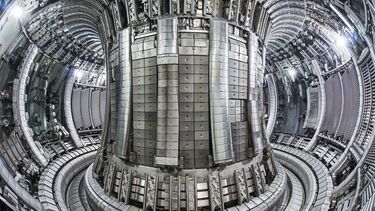High-fidelity simulation for liquid metal magnetohydrodynamic effects in fusion applications
Project period: 2025-2029

PhD Student: Lawrence Jones
Supervisor: Shuisheng He
Co-supervisors: Nakul Sashidharan (UKAEA), Aleksander Dubas (UKAEA)
Collaborator: Wei Wang (STFC)
Scope
This study is aimed at better understanding and prediction of the MHD-influenced turbulent cooling phenomena in geometries/conditions directly relevant to the fusion bleeding blanket using direct numerical simulations (DNS)/large eddy simulations (LES). In particular, the project will target at specific needs associated with the UKAEA facilities such as CHIMERA, LLiMFA and SmallLab. This project is co-funded by the Fusion Power CDT and a UKAEA studentship.
Background
Understanding magnetohydrodynamic (MHD) effects upon liquid metals flowing in fusion components is a significant challenge for the design of prototype and commercial reactors. UKAEA is actively seeking to grow its expertise in this area in order to support in-vessel component design for STEP and DEMO. The current understanding of MHD effects is limited due to the complexity of the phenomena and requires experimental efforts through forthcoming and existing facilities at UKAEA’s Fusion Technology Facilities (FTF) such as CHIMERA, the Liquid Metal Flow Apparatus (LLiMFA), and SmalLab. These experiments will be extremely valuable, but intensive to complete in both cost and time and limited in obtainable data by the physically achievable placement of diagnostics.
Simulation methods such as Direct Numerical Simulation (DNS) offer an additional possibility of “numerical experiments” that complement the physical experiments by producing extremely high-fidelity data. Outputs can be used to verify the performance of less intensive conventional Computational Fluid Dynamics (CFD) models, which remain lacking for MHD applications. Further, the outputs themselves will provide more detailed understanding of the fundamental phenomena expected in complex flow regions, such as that in manifold areas or liquid metal armour regions in divertor regions where excellent heat transfer is critical to performance.
This project will extend and apply the existing DNS tool, CHAPSim, developed through the University and now under open-source development with support from STFC Daresbury Laboratory via CCP-NTH (Collaborative Computational Project in Nuclear Thermal Hydraulics). The code will be applied to component designs or test pieces relevant to fusion where MHD effects are particularly complex due to, for instance, complex geometry or coupled physical phenomena. Outputs will allow more targeted experiments in facilities such as CHIMERA, LLiMFA, and SmalLab as focus can be placed on the most uncertain areas of performance, ultimately leading to faster and greater confidence in component qualification as well as design optimisation.
Given the high computational resources required for any DNS simulation, the project will look beyond a routine application workflow and will also seek to develop methods for extracting and applying the insight gained in advanced methods. For example, machine learning or other artificial intelligence methods may be used to accelerate outcomes and formulate correlations and reduced order models used in lower fidelity modelling frameworks such as coarse-grid CFD.
